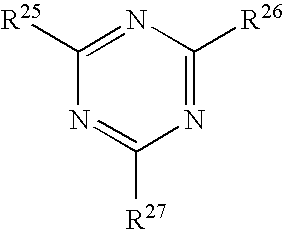Reinforced polyester compositions, methods of manufacture, and articles thereof
a technology of reinforced polyester and compositions, applied in the directions of organic chemistry, transportation and packaging, group 5/15 element organic compounds, etc., can solve the problems of reducing the tensile strength and impact strength of eco-fr formulations, less desirable flame retardants, and undesirable mechanical properties of eco-fr formulations
- Summary
- Abstract
- Description
- Claims
- Application Information
AI Technical Summary
Problems solved by technology
Method used
Image
Examples
examples
[0058]The materials in Table 1 were used in the examples that follow.
TABLE 1AbbreviationDescriptionSourcePBT 1Poly(1,4-butylene terephthalate), intrinsic viscosity =SABIC Innovative Plastics0.66 dl / g, weight-average molecular weight = 53400 g / molCompanyPBT 2Poly(1,4-butylene terephthalate), intrinsic viscosity =SABIC Innovative Plastics1.10 dl / g, weight-average molecular weight = 110000 g / molCompanyRegular glassStandard 13 micron PBT glass (Glass fiber withPPG Industriesround cross-section)Flat glassGlass fiber with ‘flat’ cross-section: cross sectionNitto Bosekiarea equal to a round glass fiber with a diameter of14 micron. Flat ratio = 4; fiber length = 3 mmMelamine polyphosphateMelamine polyphosphateCiba SpecialtyAluminum diethylAluminum diethyl phosphinic acidClariantphosphinic acidPolyetherimideULTEM 1010 polyetherimide (PEI)SABIC Innovative PlasticsCompanyBrominated FR masterBrominated flame retardant, masterbatchedSABIC Innovative PlasticsbatchCompanyTSANSAN encapsulated PTFES...
examples 1-13
Examples 1-4
[0067]The purpose of these examples was to compare the performance of compositions of our invention containing flat glass fiber to compositions containing regular glass fibers (fibers containing a circular cross section). The composition used in Example E1 exemplified an embodiment of our invention while compositions in Examples E2, E3, and E4 were used for comparison.
[0068]The compositions were made in accordance to the procedure described above. Results are shown in Table 2.
TABLE 2Formulation and Properties of 30% Glass Filled PolyestersE2E3E4E1ComparativeComparativeComparativeNon-halogenatedHalogenated FR;Non-halogenatedNon-halogenatedFR; 30% flat30% regularFR; 30% regularFR; 30% regularUnitglass; no PEIglassglass; no PEIglass; w. PEIItemPBT 1%51.6552.4651.6546.65Regular glass%303030Flat glass%30Melamine%555polyphosphateAluminum diethyl%12.512.512.5phosphinic acidPolyetherimide%———5Brominated FR%—15.45——masterbatchTSAN%0.51.050.50.5Hindered phenol%0.150.040.150.15stab...
examples 5-9
[0073]The purpose of these examples was to compare the performance of compositions of our invention containing flat glass fiber to compositions containing regular glass fibers (fibers containing a circular cross section). Compositions used in Examples E5 and E6 exemplified embodiments of our invention while compositions in Examples E7, E8, and E9 were used for comparison.
[0074]The compositions were made in accordance to the procedure described above. Results are shown in Table 3.
TABLE 3Formulation and Properties of 25% Glass Filled Polyester CompositionsE7E8E9E5E6(Comparative)(Comparative)(Comparative)Non-halogenatedNon-halogenatedHalogenatedNon-halogenatedNon-halogenatedFR; 25% flatFR; 25% flatFR; 25% regularFR; 25% regularFR; 25% regularUnitglass; no PEIglass; PEIglassglass; no PEIglass; PEIItemPBT 1%56.6551.6557.9656.6551.65Regular Glass%252525Flat Glass%2525Melamine%5555PolyphosphateAluminum diethyl%12.512.512.512.5Phosphinic acidPolyetherimide%55Brominated FR%15.45masterbatchTS...
PUM
| Property | Measurement | Unit |
|---|---|---|
| wt. % | aaaaa | aaaaa |
| tensile stress at break | aaaaa | aaaaa |
| flexural modulus | aaaaa | aaaaa |
Abstract
Description
Claims
Application Information
 Login to View More
Login to View More - R&D
- Intellectual Property
- Life Sciences
- Materials
- Tech Scout
- Unparalleled Data Quality
- Higher Quality Content
- 60% Fewer Hallucinations
Browse by: Latest US Patents, China's latest patents, Technical Efficacy Thesaurus, Application Domain, Technology Topic, Popular Technical Reports.
© 2025 PatSnap. All rights reserved.Legal|Privacy policy|Modern Slavery Act Transparency Statement|Sitemap|About US| Contact US: help@patsnap.com

